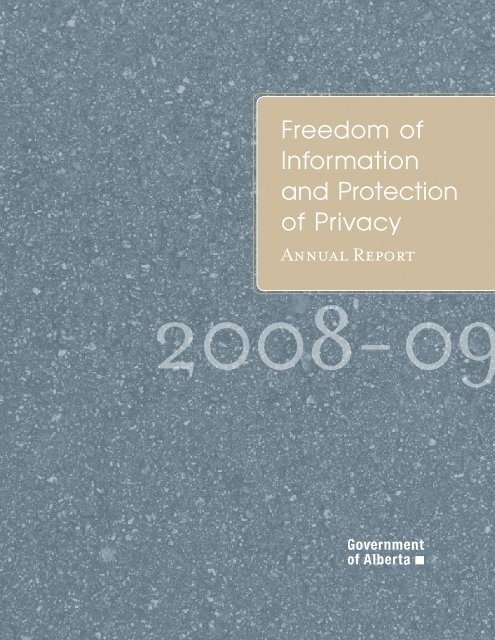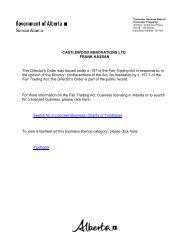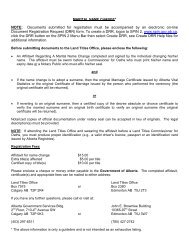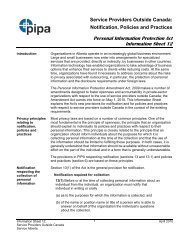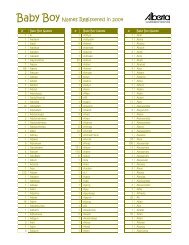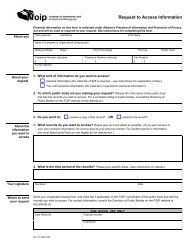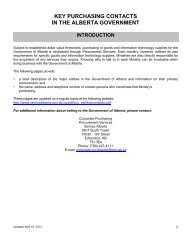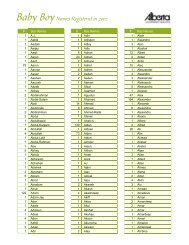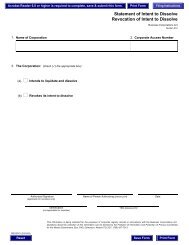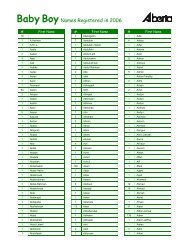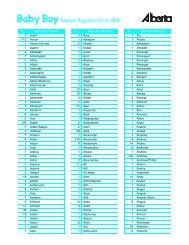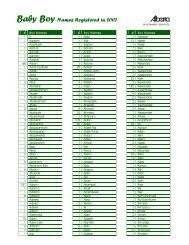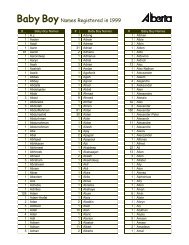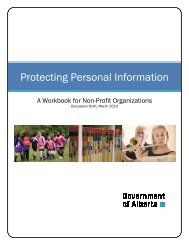Freedom of Information and Protection of Privacy ... - Service Alberta
Freedom of Information and Protection of Privacy ... - Service Alberta
Freedom of Information and Protection of Privacy ... - Service Alberta
Create successful ePaper yourself
Turn your PDF publications into a flip-book with our unique Google optimized e-Paper software.
<strong>Freedom</strong> <strong>of</strong><br />
<strong>Information</strong><br />
<strong>and</strong> <strong>Protection</strong><br />
<strong>of</strong> <strong>Privacy</strong><br />
Annual Report<br />
2008-09
November 2009<br />
Honourable Ken Kowalski<br />
Speaker<br />
Legislative Assembly <strong>of</strong> <strong>Alberta</strong><br />
325 Legislature Building<br />
10800 – 97 Avenue<br />
Edmonton, <strong>Alberta</strong><br />
T5K 2B6<br />
Dear Sir:<br />
In accordance with Section 86 <strong>of</strong> the <strong>Freedom</strong> <strong>of</strong> <strong>Information</strong><br />
<strong>and</strong> <strong>Protection</strong> <strong>of</strong> <strong>Privacy</strong> Act, I have the honour to submit the<br />
14th annual report on the operation <strong>of</strong> this Act for the fiscal year<br />
ended March 31, 2009.<br />
Respectfully submitted,<br />
Original signed by<br />
Heather Klimchuk<br />
Minister
Minister’s Message
MINISTER’S MESSAGE<br />
I am honoured to present the 2008-09 FOIP annual report.<br />
Access to information is important in ensuring government <strong>and</strong> other public bodies are open, transparent<br />
<strong>and</strong> accountable. At the same time, the personal information <strong>of</strong> <strong>Alberta</strong>ns must be protected. <strong>Alberta</strong>’s<br />
<strong>Freedom</strong> <strong>of</strong> <strong>Information</strong> <strong>and</strong> <strong>Protection</strong> <strong>of</strong> <strong>Privacy</strong> Act strives to create a balance between the availability <strong>of</strong><br />
information <strong>and</strong> making sure <strong>Alberta</strong>ns can be confident their right to privacy is maintained.<br />
The past year marks one decade since the legislation was exp<strong>and</strong>ed to include all public sector bodies, such<br />
as school boards <strong>and</strong> municipalities. Over the course <strong>of</strong> those 10 years, we’ve seen a significant increase in<br />
requests to local public bodies, from 620 requests a decade ago to 2,020 requests in 2008-09. <strong>Service</strong> <strong>Alberta</strong><br />
works closely with those public bodies, giving advice <strong>and</strong> assistance to help them meet their responsibilities<br />
in providing access to information while protecting personal privacy. Ten years ago, 90 per cent <strong>of</strong> requests<br />
were processed in 60 days or less. Today, the st<strong>and</strong>ard is 95 per cent.<br />
The provincial government has also improved its response time during the last 10 years despite an increase<br />
to 3,350 requests for information compared to 2,150 a decade ago. Ten years ago, 93 per cent <strong>of</strong> requests<br />
were processed in 60 days or less. Today, that number is 96 per cent.<br />
Significant accomplishments for the 2008-09 fiscal year include:<br />
• The enactment <strong>of</strong> a new <strong>Freedom</strong> <strong>of</strong> <strong>Information</strong> <strong>and</strong> <strong>Protection</strong> <strong>of</strong> <strong>Privacy</strong> Regulation to ensure<br />
currency, including the scope <strong>of</strong> the Act.<br />
• A major project to revise <strong>and</strong> redesign many <strong>of</strong> <strong>Service</strong> <strong>Alberta</strong>’s FOIP print <strong>and</strong> electronic resources<br />
for administrators province-wide; these resources now incorporate all recent amendments <strong>and</strong><br />
guidance <strong>of</strong>fered in recent <strong>Information</strong> <strong>and</strong> <strong>Privacy</strong> Commissioner decisions.<br />
• Providing opportunities for FOIP staff to exp<strong>and</strong> their knowledge <strong>and</strong> expertise by organizing special<br />
presentations on new <strong>and</strong> emerging privacy issues.<br />
• Collaborating with other ministries through advisory services to promote a consistent approach to<br />
access <strong>and</strong> privacy administration across government.<br />
As new technology <strong>and</strong> processes emerge to collect <strong>and</strong> store information, we must continue to develop<br />
expertise <strong>and</strong> experience both in the provincial government <strong>and</strong> in local public bodies. I thank the<br />
<strong>Information</strong> <strong>and</strong> <strong>Privacy</strong> Commissioner, elected <strong>of</strong>ficials, <strong>and</strong> staff in government <strong>and</strong> local public bodies for<br />
their ongoing commitment to <strong>Alberta</strong>’s <strong>Freedom</strong> <strong>of</strong> <strong>Information</strong> <strong>and</strong> <strong>Protection</strong> <strong>of</strong> <strong>Privacy</strong> Act.<br />
Minister’s Message<br />
Original signed by<br />
Heather Klimchuk, MLA<br />
Minister <strong>of</strong> <strong>Service</strong> <strong>Alberta</strong>
Contents
CONTENTS<br />
Access <strong>and</strong> <strong>Privacy</strong><br />
2008-09 Highlights ..................................................... 1<br />
MAKING FOIP WORK FOR ALBERTA<br />
<strong>Alberta</strong>’s FOIP Program ............................................... 3<br />
Contents<br />
FOIP STATISTICS<br />
Requests to Provincial Government Departments,<br />
Agencies, Boards <strong>and</strong> Commissions ............................. 7<br />
• Number <strong>of</strong> requests made to the <strong>Alberta</strong> government............ 7<br />
• Who made access requests........................................... 8<br />
• How access requests were processed............................... 9<br />
• Why information was not released.................................. 10<br />
• Response times........................................................ 11<br />
• Fees paid............................................................... 12<br />
• Fees waived............................................................ 12<br />
Requests to Local Public Bodies .................................. 13<br />
• Number <strong>of</strong> requests made to local public bodies................ 13<br />
• Sectors that received access requests.............................. 14<br />
• Who made access requests.......................................... 15<br />
• How access requests were processed.............................. 16<br />
• Response times........................................................ 17<br />
Contact information.............................................. 18
Access <strong>and</strong> <strong>Privacy</strong>
2008-09<br />
Highlights<br />
Access <strong>and</strong><br />
<strong>Privacy</strong><br />
1<br />
Access <strong>and</strong> <strong>Privacy</strong><br />
The following achievements provide a snapshot <strong>of</strong> the FOIP program this year.<br />
• Enacted a new FOIP Regulation <strong>and</strong> a Ministerial Regulation<br />
• Reviewed over 50 resources incorporating recent guidance from <strong>Information</strong> <strong>and</strong> <strong>Privacy</strong><br />
Commissioner decisions<br />
• Arranged for experts to deliver special presentations for FOIP staff across government<br />
• Trained more than 960 employees from government <strong>and</strong> local public bodies<br />
• Advised government ministries on access <strong>and</strong> privacy considerations in 32 legislative initiatives<br />
• Responded to more than 1,900 questions directed to the FOIP help desk<br />
• Received more than 1.4 million hits on the FOIP website<br />
• Contributed to the planning <strong>and</strong> delivery <strong>of</strong> <strong>Alberta</strong>’s 13th annual information <strong>and</strong><br />
privacy conference<br />
• Worked with federal, provincial <strong>and</strong> territorial counterparts to harmonize access <strong>and</strong> privacy<br />
legislation <strong>and</strong> to share resources
2<br />
MAKING FOIP WORK FOR ALBERTA
Making FOIP<br />
work for <strong>Alberta</strong><br />
<strong>Alberta</strong>’s FOIP Program<br />
<strong>Service</strong> <strong>Alberta</strong> provides leadership, strategic<br />
direction <strong>and</strong> support to public bodies subject<br />
to the <strong>Freedom</strong> <strong>of</strong> <strong>Information</strong> <strong>and</strong> <strong>Protection</strong> <strong>of</strong><br />
<strong>Privacy</strong> Act (the FOIP Act). These bodies include<br />
provincial government departments, agencies,<br />
boards <strong>and</strong> commissions, as well as a diverse<br />
range <strong>of</strong> local public bodies operating across<br />
<strong>Alberta</strong>. The role <strong>of</strong> <strong>Service</strong> <strong>Alberta</strong> is to ensure<br />
that <strong>Alberta</strong>ns are able to exercise their right<br />
under the FOIP Act to request access to records<br />
<strong>and</strong> that they can rely on public bodies to protect<br />
their personal information.<br />
The department provides training, information<br />
resources <strong>and</strong> pr<strong>of</strong>essional development for<br />
staff in public bodies who are responsible for<br />
the day-to-day administration <strong>of</strong> the Act. This<br />
ensures they have the support they need to run<br />
an effective FOIP program. <strong>Service</strong> <strong>Alberta</strong><br />
also keeps ahead <strong>of</strong> new issues <strong>and</strong> trends, <strong>and</strong><br />
ensures that the legislation keeps pace with the<br />
changing world.<br />
Effective Legislative Framework<br />
A new FOIP Regulation came into force on<br />
November 5, 2008. The Regulation updated<br />
the list <strong>of</strong> public bodies that are subject to<br />
the Act. It also updated references to other<br />
legislation <strong>and</strong> clarified certain steps in<br />
processing access requests. Later in the year<br />
a Ministerial Regulation was used to bring<br />
three new government bodies under the<br />
Act without requiring an amendment to<br />
the general regulation.<br />
A process was established a few years ago to review<br />
<strong>and</strong> comment on any access or privacy implications<br />
in new legislative initiatives. This process promotes<br />
a consistent approach to access <strong>and</strong> privacy in<br />
legislation across the government. The department<br />
consulted with ministries on 32 pieces <strong>of</strong> legislation<br />
in 2008-09.<br />
Learning Opportunities<br />
As technology <strong>and</strong> approaches to delivering<br />
government services change, new access <strong>and</strong> privacy<br />
issues must be considered. FOIP staff are encouraged<br />
to participate in activities that expose them to the<br />
latest developments in the field.<br />
Regular information sessions were held with<br />
government, school board, post-secondary <strong>and</strong><br />
municipal FOIP staff. These meetings provide<br />
an opportunity for the department to convey<br />
information about activities <strong>and</strong> for public bodies to<br />
share information <strong>and</strong> strategies to address common<br />
issues. For example, public bodies are starting to<br />
use social media sites as a means to disseminate<br />
information, promote greater awareness <strong>of</strong> programs<br />
FOIP Quick Facts<br />
• In 2008-09, the Government <strong>of</strong> <strong>Alberta</strong><br />
responded to 96 per cent <strong>of</strong> access<br />
requests within 60 days.<br />
• The government has responded to nearly<br />
31,300 access requests since the FOIP Act<br />
came into effect.<br />
• Local public bodies have responded to<br />
more than 10,200 access requests.<br />
3<br />
MAKING FOIP WORK FOR ALBERTA
4<br />
MAKING FOIP WORK FOR ALBERTA<br />
<strong>and</strong> obtain public input. A presentation on this<br />
topic was provided to several groups <strong>of</strong> FOIP<br />
Coordinators to heighten their awareness <strong>of</strong> the<br />
privacy implications <strong>of</strong> using social media sites.<br />
Experts were invited to give special presentations<br />
to FOIP Coordinators on new developments on<br />
a range <strong>of</strong> topics. One presentation focused on<br />
a common web portal for students applying for<br />
admission to post-secondary institutions <strong>and</strong><br />
the privacy protections built into the system.<br />
Another presentation discussed the impact <strong>of</strong><br />
the new Adult Guardianship <strong>and</strong> Trusteeship<br />
Act on the exercise <strong>of</strong> rights by guardians <strong>and</strong><br />
trustees under the FOIP Act. City <strong>of</strong> Edmonton<br />
staff gave a presentation on the city’s Wireless<br />
Edmonton service <strong>and</strong> discussed the security<br />
issues surrounding the implementation <strong>of</strong> public<br />
wireless networks.<br />
FOIP Quick Facts<br />
The majority <strong>of</strong> FOIP requests received by the<br />
<strong>Alberta</strong> government are made by businesses.<br />
In October 2008 the Office <strong>of</strong> the <strong>Information</strong><br />
<strong>and</strong> <strong>Privacy</strong> Commissioner held a seminar to<br />
mark the international Right to Know Week.<br />
<strong>Service</strong> <strong>Alberta</strong> gave a presentation highlighting<br />
developments in routine access, under a legislated<br />
process or as a matter <strong>of</strong> policy.<br />
The department supports an annual access <strong>and</strong><br />
privacy conference. The 2008 conference was<br />
held in Edmonton June 10-12. Local <strong>and</strong> national<br />
experts shared their insights <strong>and</strong> provided<br />
information to help delegates build expertise.<br />
Speakers included <strong>Alberta</strong>’s <strong>Information</strong> <strong>and</strong><br />
<strong>Privacy</strong> Commissioner Frank Work, Q.C.;<br />
Suzanne Legault, Office <strong>of</strong> the <strong>Information</strong><br />
Commissioner <strong>of</strong> Canada; Willie Grieve, Chair<br />
<strong>of</strong> the <strong>Alberta</strong> Utilities Commission; Elizabeth<br />
Denham, Assistant <strong>Privacy</strong> Commissioner <strong>of</strong><br />
Canada; Gene McLean, Vice President <strong>and</strong><br />
Chief Security Officer for TELUS; <strong>and</strong> Ian<br />
Kerr, Canada Research Chair in Ethics, Law <strong>and</strong><br />
Technology at the University <strong>of</strong> Ottawa,<br />
Faculty <strong>of</strong> Law.<br />
FOIP Quick Facts<br />
More FOIP requests are made by individuals<br />
to local public bodies than by any other<br />
category <strong>of</strong> user.<br />
Supporting FOIP Staff<br />
One <strong>of</strong> the challenges facing FOIP <strong>of</strong>fices is the<br />
growing volume <strong>of</strong> records that are available in<br />
electronic format only. Printing these documents<br />
to prepare them for release to the public is time<br />
consuming <strong>and</strong> costly. In recent years several<br />
s<strong>of</strong>tware products have been developed that<br />
allow documents to be prepared for release<br />
electronically. <strong>Service</strong> <strong>Alberta</strong> provided support<br />
to FOIP <strong>of</strong>fices by developing a business<br />
case to obtain such s<strong>of</strong>tware for government<br />
departments. The project included developing a<br />
list <strong>of</strong> requirements <strong>and</strong> drafting a Request<br />
for Proposal.<br />
<strong>Service</strong> <strong>Alberta</strong>’s FOIP help desk receives<br />
calls <strong>and</strong> e-mails from FOIP staff <strong>and</strong> the public<br />
who have questions about the legislation. The<br />
help desk responded to more than 1,900 queries<br />
in 2008-09.<br />
FOIP Quick Facts<br />
Calls from the public account for 47 per cent<br />
<strong>of</strong> queries to the FOIP help desk.<br />
Publications <strong>and</strong> Resources<br />
<strong>Service</strong> <strong>Alberta</strong> has over 50 publications <strong>and</strong><br />
resources available to help FOIP staff underst<strong>and</strong><br />
<strong>and</strong> apply the FOIP Act.<br />
The fifth edition <strong>of</strong> <strong>Service</strong> <strong>Alberta</strong>’s publication,<br />
FOIP Guidelines <strong>and</strong> Practices, was published this<br />
year. In addition, a major project to redesign an<br />
important publication series was completed.
All publications have been updated to reflect<br />
recent legislative amendments <strong>and</strong> decisions<br />
<strong>of</strong> the <strong>Information</strong> <strong>and</strong> <strong>Privacy</strong> Commissioner.<br />
As well, more definitions, examples <strong>and</strong><br />
practical suggestions have been added to the<br />
FOIP Bulletins.<br />
Two issues <strong>of</strong> FOIP News, an electronic newsletter<br />
for local public bodies, were published. The<br />
newsletter keeps the lines <strong>of</strong> communication open<br />
with all local public bodies, not just those able to<br />
participate in network meetings. The newsletter<br />
typically highlights decisions <strong>of</strong> the <strong>Information</strong><br />
<strong>and</strong> <strong>Privacy</strong> Commissioner that are particularly<br />
significant for local public bodies. The newsletter<br />
also includes announcements about new <strong>and</strong><br />
revised publications <strong>and</strong> upcoming courses,<br />
meetings <strong>and</strong> events. Newsletters are available<br />
on the FOIP website for easy reference.<br />
The FOIP website continues to provide users with<br />
easy access to key information on the FOIP Act<br />
including the legislation, publications, frequently<br />
asked questions <strong>and</strong> contact information for<br />
public bodies. It also includes summaries <strong>of</strong><br />
decisions under the FOIP Act made by the<br />
<strong>Information</strong> <strong>and</strong> <strong>Privacy</strong> Commissioner, as<br />
well as links to the full text <strong>of</strong> the decisions.<br />
FOIP Quick Facts<br />
There were more than 1.4 million visits to the<br />
FOIP website this year.<br />
Training Program<br />
<strong>Service</strong> <strong>Alberta</strong> <strong>of</strong>fers st<strong>and</strong>ard training courses<br />
on a regular schedule so that public bodies can<br />
send new staff for FOIP training. The instructorled<br />
training program includes three one-day<br />
courses for employees who are responsible for<br />
FOIP <strong>and</strong> a half-day course for employees who<br />
require an overview <strong>of</strong> the basic concepts in<br />
the field <strong>of</strong> protection <strong>of</strong> privacy <strong>and</strong> access to<br />
information. Training courses are scheduled<br />
for delivery in Edmonton <strong>and</strong> Calgary, <strong>and</strong><br />
additional courses are held around the province<br />
as requested. In 2008-09, 964 employees from<br />
government <strong>and</strong> local public bodies successfully<br />
completed training. Training was provided in<br />
52 courses, including 30 delivered at public<br />
body workplaces.<br />
A new course, Managing Contracts under the FOIP<br />
Act, was developed <strong>and</strong> piloted this spring. The<br />
new course will be <strong>of</strong>fered next year.<br />
FOIP Quick Facts<br />
964 employees completed FOIP training:<br />
411 from provincial government bodies,<br />
553 from local public bodies.<br />
Trainers travelled to Calgary, High Prairie,<br />
Lacombe, Lloydminster, Manning, Parkl<strong>and</strong><br />
County, Pincher Creek, Sylvan Lake<br />
<strong>and</strong> Vermilion.<br />
National Initiatives<br />
The department followed the legislative reviews<br />
<strong>of</strong> private-sector privacy legislation that took<br />
place in <strong>Alberta</strong> <strong>and</strong> at the federal level,<br />
monitoring for any implications these may have<br />
for the FOIP Act. Legislation governing the<br />
public <strong>and</strong> private sectors needs to work together<br />
seamlessly to ensure harmonious interaction<br />
between public bodies <strong>and</strong> their private-sector<br />
partners <strong>and</strong> contractors.<br />
<strong>Alberta</strong> participated in a national committee<br />
<strong>of</strong> federal, provincial <strong>and</strong> territorial governments<br />
to promote the harmonization <strong>of</strong> access <strong>and</strong><br />
privacy legislation. The committee’s work<br />
<strong>of</strong>ten leads to sharing <strong>of</strong> educational <strong>and</strong> other<br />
resources. The various jurisdictions have recently<br />
worked on finding better ways <strong>of</strong> conducting<br />
privacy impact assessments <strong>and</strong> privacy audits,<br />
two key processes for protecting personal<br />
information held by public bodies.<br />
5<br />
MAKING FOIP WORK FOR ALBERTA
6<br />
FOIP STATISTICS
FOIP Statistics<br />
7<br />
Requests to Provincial Government Departments,<br />
Agencies, Boards <strong>and</strong> Commissions<br />
Number <strong>of</strong> requests made to the<br />
<strong>Alberta</strong> government<br />
Government departments, agencies, boards <strong>and</strong><br />
commissions (provincial government bodies)<br />
routinely release information to the public. The<br />
FOIP Act is used only when information is not<br />
available through regular channels.<br />
Statistical reports <strong>of</strong> FOIP requests are submitted<br />
by all ministries including the Executive Council;<br />
the Legislative Assembly Office; the Offices <strong>of</strong><br />
the Auditor General, the Ombudsman, the Chief<br />
Electoral Officer, the Ethics Commissioner <strong>and</strong><br />
the <strong>Information</strong> <strong>and</strong> <strong>Privacy</strong> Commissioner; <strong>and</strong><br />
agencies, boards <strong>and</strong> commissions designated in<br />
the FOIP Regulation. FOIP requests are tracked<br />
manually or electronically by each public body.<br />
In fiscal year 2008-09, 3,350 FOIP requests were<br />
received by government departments, agencies,<br />
boards <strong>and</strong> commissions. This is a 22 per cent<br />
increase from the 2,757 requests received the<br />
previous fiscal year.<br />
In 2008-09, there were six requests for correction<br />
<strong>of</strong> personal information. This is a decrease<br />
from seven such requests received the previous<br />
fiscal year.<br />
FOIP STATISTICS<br />
Number <strong>of</strong> FOIP requests received during the last five years<br />
3500<br />
Number <strong>of</strong> Requests*<br />
3000<br />
2500<br />
2000<br />
1500<br />
1000<br />
500<br />
1770<br />
1172<br />
1406 1233<br />
1740 1897<br />
1768<br />
1568 1453<br />
989<br />
0<br />
2004-05 2005-06 2006-07 2007-08 2008-09<br />
■ Personal <strong>Information</strong> ■ General <strong>Information</strong><br />
*Excludes requests for correction <strong>of</strong> personal information.
8<br />
Top 10 - Requests for General <strong>Information</strong><br />
Top 10 - Requests for Personal <strong>Information</strong><br />
FOIP STATISTICS<br />
Environment 1389<br />
Health <strong>and</strong> Wellness 62<br />
Employment <strong>and</strong> Immigration 52<br />
Executive Council 35<br />
Justice <strong>and</strong> Attorney General 33<br />
Sustainable Resource Development 27<br />
Transportation 26<br />
Energy 24<br />
Energy Resources Conservation Board 18<br />
<strong>Alberta</strong> Gaming <strong>and</strong> Liquor Commission 18<br />
Child <strong>and</strong> Family <strong>Service</strong>s Authorities 470<br />
Employment <strong>and</strong> Immigration 377<br />
Seniors <strong>and</strong> Community Supports 160<br />
Children <strong>and</strong> Youth <strong>Service</strong>s 118<br />
Solicitor General <strong>and</strong> Public Security 110<br />
Culture <strong>and</strong> Community Spirit 58<br />
Workers’ Compensation Board 31<br />
Transportation 28<br />
Justice <strong>and</strong> Attorney General 21<br />
Advanced Education <strong>and</strong> Technology 11<br />
Who made access requests<br />
In 2008-09, 43 per cent <strong>of</strong> access requests received by government public bodies were from<br />
individuals seeking records containing information about themselves. The remaining 57 per cent<br />
<strong>of</strong> requests were made for general information. In this category, the top users were businesses<br />
<strong>and</strong> members <strong>of</strong> the public.<br />
Business<br />
General<br />
Public<br />
Media<br />
Interest<br />
Groups<br />
Elected<br />
Officials<br />
Academic/<br />
Researcher<br />
4.8%<br />
3.1%<br />
3.9%<br />
2.5%<br />
3.2%<br />
3.5%<br />
0.6%<br />
2.0%<br />
8.9%<br />
8.3%<br />
0% 10% 20% 30% 40% 50% 60% 70%<br />
Percentage <strong>of</strong> Requests<br />
■ 2007-08 ■ 2008-09<br />
78.7%<br />
80.7%<br />
80% 90%
9<br />
How access requests were processed<br />
Provincial government bodies disclosed or partly disclosed records in 24 per cent <strong>of</strong> general<br />
information requests. In 67 per cent <strong>of</strong> requests, the applicant requested records that did not exist.<br />
Six per cent <strong>of</strong> requests were ab<strong>and</strong>oned or withdrawn by the applicant, or transferred to another<br />
public body. No records were disclosed in three per cent <strong>of</strong> requests.<br />
Disposition<br />
Records<br />
Do Not Exist<br />
Partly<br />
Disclosed<br />
Totally<br />
Disclosed<br />
Withdrawn<br />
Nothing<br />
Disclosed<br />
Ab<strong>and</strong>oned<br />
Transferred<br />
3.6%<br />
4.4%<br />
2.9%<br />
1.4%<br />
2.3%<br />
4.5%<br />
0.8%<br />
0.9%<br />
7.0%<br />
7.7%<br />
16.7%<br />
14.6%<br />
66.7%<br />
66.6%<br />
FOIP STATISTICS<br />
0% 10% 20% 30% 40% 50% 60% 70%<br />
Percentage <strong>of</strong> Requests<br />
■ 2007-08 ■ 2008-09<br />
Provincial government bodies disclosed or partly disclosed records in 60 per cent <strong>of</strong> personal<br />
information requests. Eighteen per cent <strong>of</strong> requests were ab<strong>and</strong>oned or withdrawn by the applicant<br />
or transferred to another public body. In 20 per cent <strong>of</strong> requests, the applicant requested records<br />
that did not exist. No records were disclosed in two per cent <strong>of</strong> requests.<br />
Disposition<br />
Partly<br />
Disclosed<br />
Records<br />
Do Not Exist<br />
Ab<strong>and</strong>oned<br />
Totally<br />
Disclosed<br />
Withdrawn<br />
Nothing<br />
Disclosed<br />
3.2%<br />
5.7%<br />
1.7%<br />
3.5%<br />
7.0%<br />
9.3%<br />
10.6%<br />
13.4%<br />
15.6%<br />
20.2%<br />
51.0%<br />
57.1%<br />
Transferred<br />
1.2%<br />
0.6%<br />
0% 10% 20% 30% 40% 50% 60% 70%<br />
Percentage <strong>of</strong> Requests<br />
■ 2007-08 ■ 2008-09
10<br />
Why information was not released<br />
FOIP STATISTICS<br />
When public bodies sever information from a record or withhold a record, they must indicate<br />
which section <strong>of</strong> the FOIP Act was used to authorize the decision. The following table summarizes<br />
the sections <strong>of</strong> the Act that were cited by provincial government bodies when records were not<br />
completely disclosed.<br />
The number <strong>of</strong> occurrences indicates the number <strong>of</strong> requests where a particular section <strong>of</strong> the Act<br />
was used. Because several sections may be used on a single request, the number <strong>of</strong> occurrences is<br />
not related to the number <strong>of</strong> requests completed.<br />
number <strong>of</strong><br />
Sections <strong>of</strong> I information<br />
the Act Used Exceptions occurrences<br />
17 Third party – personal information 954<br />
27 Privileged information 303<br />
24 Advice from <strong>of</strong>ficials 295<br />
21 Intergovernmental relations 127<br />
16 Third party – business/tax interests 95<br />
20 Law enforcement 88<br />
25 Harmful to economic or other interests <strong>of</strong> a public body 56<br />
29 <strong>Information</strong> otherwise available to the public 42<br />
22 Cabinet <strong>and</strong> Treasury Board confidences 29<br />
12 Refuse to confirm or deny existence <strong>of</strong> a record 19<br />
19 Confidential evaluations 14<br />
26 Testing procedures, tests <strong>and</strong> audits 8<br />
18 Harmful to individual or public safety 7<br />
28 Harmful to conservation 3<br />
number <strong>of</strong><br />
Sections <strong>of</strong> I information<br />
the Act Used Exclusions occurrences<br />
4(1)l Registry records 74<br />
4(1)q<br />
Communications between MLAs <strong>and</strong>/or members <strong>of</strong><br />
Executive Council 47<br />
4(1)a Court/judicial records 46<br />
5 Other legislation paramount 18<br />
4(1)d Records <strong>of</strong> Officers <strong>of</strong> the Legislature 9<br />
4(1)o Personal/constituency records <strong>of</strong> members <strong>of</strong> Executive Council 8<br />
4(1)b (Quasi) judicial notes, communications, draft decisions 7<br />
6(4)b Ministerial briefing for a session <strong>of</strong> the Legislative Assembly 7<br />
4(1)g Examination/test questions 6<br />
4(1)p Speaker/MLA records in Legislative Assembly Office 5<br />
6(4)a Ministerial briefing for a new portfolio 3<br />
4(1)k Incomplete prosecution records 2<br />
4(1)c Quality assurance records (health) 1<br />
6(7) Audit records <strong>of</strong> the Chief Internal Auditor <strong>of</strong> <strong>Alberta</strong> 1
11<br />
Response times<br />
A total <strong>of</strong> 96 per cent <strong>of</strong> requests received<br />
by provincial government bodies were<br />
completed within 60 days. This total<br />
represents 87 per cent completed within<br />
30 days <strong>and</strong> nine per cent within 30 to 60<br />
days. The remaining requests were completed<br />
in more than 60 days.<br />
The FOIP Act states that normally a request<br />
must be completed within 30 days <strong>of</strong> the date<br />
it was received. However, the Act allows the<br />
head <strong>of</strong> a public body to extend this for an<br />
additional 30 days under three circumstances:<br />
if more time is needed to consult with another<br />
public body or with a third party; if the<br />
request does not provide sufficient detail to<br />
allow identification <strong>of</strong> the requested record;<br />
or if a large number <strong>of</strong> records is involved.<br />
Provincial government bodies continue to<br />
turn around a high volume <strong>of</strong> FOIP requests<br />
within a short timeframe. <strong>Alberta</strong>ns continue<br />
to have timely <strong>and</strong> effective access<br />
to government information.<br />
Percentage <strong>of</strong> completed requests<br />
90%<br />
80%<br />
70%<br />
60%<br />
50%<br />
40%<br />
30%<br />
20%<br />
10%<br />
0%<br />
87.1%<br />
87.3%<br />
30 days<br />
or less<br />
7.8% 8.6%<br />
30-60 days 60+ days<br />
Number <strong>of</strong> Days to complete request<br />
■ 2007-08 ■ 2008-09<br />
5.1% 4.1%<br />
FOIP STATISTICS<br />
FOIP Quick Facts<br />
97 per cent <strong>of</strong> requests are h<strong>and</strong>led<br />
without complaint to the <strong>Information</strong><br />
<strong>and</strong> <strong>Privacy</strong> Commissioner.
12<br />
FOIP STATISTICS<br />
Fees paid<br />
The fee schedule for processing FOIP requests is<br />
set out in Schedule 2 <strong>of</strong> the FOIP Regulation. In<br />
2008-09, provincial government bodies collected<br />
fees <strong>of</strong> less than $108,000. Fee information is not<br />
available for local public bodies.<br />
General information requests<br />
A $25 initial fee is charged for general information<br />
requests. Additional charges may be applied for<br />
time spent locating, retrieving <strong>and</strong> preparing<br />
records for disclosure; computer programming<br />
<strong>and</strong> processing; <strong>and</strong> copying records. Additional<br />
fees cannot be charged for the time spent<br />
reviewing records to determine the need for<br />
severing information.<br />
When a request is received, a fee estimate is<br />
prepared. If the estimate is less than $150, only<br />
the initial fee <strong>of</strong> $25 is collected.<br />
Personal information requests<br />
Applicants requesting their own information<br />
pay only copying charges <strong>and</strong> only if the<br />
charges exceed $10.<br />
Fees waived<br />
Public bodies <strong>and</strong> the <strong>Information</strong> <strong>and</strong> <strong>Privacy</strong><br />
Commissioner may waive fees if the applicant<br />
cannot afford payment; if the record relates to a<br />
matter <strong>of</strong> public interest; or for any other reason<br />
that it is deemed fair to excuse payment.<br />
The amount <strong>of</strong> these fee waivers by provincial<br />
government bodies is shown in the following<br />
table:<br />
A<br />
amount waived<br />
Type <strong>of</strong> request 2008-09 2007-08<br />
General information<br />
requests<br />
Personal information<br />
requests<br />
Total fees waived<br />
$5,606 $4,910<br />
$3,387 $1,481<br />
Total $8,993 $6,391<br />
Fees are <strong>of</strong>ten reduced or eliminated by clarifying<br />
requests <strong>and</strong> providing only the records actually<br />
needed by the applicant. The value <strong>of</strong> fees<br />
eliminated in this way cannot be calculated.<br />
A<br />
amount collected<br />
Type <strong>of</strong> fee 2008-09 2007-08<br />
General information<br />
requests<br />
Initial fees $43,400 $41,600<br />
Other general $44,000 $12,800<br />
Personal information<br />
requests<br />
Total fees collected<br />
Copying $20,400 $18,500<br />
Total $107,800 $72,900
Requests to Local Public Bodies<br />
13<br />
Number <strong>of</strong> requests made to local<br />
public bodies<br />
Local public bodies include local government<br />
(municipalities, Métis settlements, irrigation<br />
districts, drainage districts, housing management<br />
bodies <strong>and</strong> public libraries), school jurisdictions,<br />
post-secondary institutions, health care bodies <strong>and</strong><br />
police services <strong>and</strong> commissions.<br />
In 2008-09, 960 local public bodies provided<br />
statistics, indicating that they received 2,020<br />
FOIP requests. This is an increase <strong>of</strong> 24 per<br />
cent over the 1,630 requests received the<br />
previous fiscal year.<br />
In 2008-09, there were eight requests to<br />
correct personal information compared to<br />
six requests received the previous fiscal year.<br />
FOIP STATISTICS<br />
Number <strong>of</strong> FOIP <strong>of</strong> requests received during the last five years<br />
2200<br />
2000<br />
1800<br />
Number <strong>of</strong> Requests*<br />
1600<br />
1400<br />
1200<br />
1000<br />
800<br />
600<br />
400<br />
612<br />
555<br />
394<br />
688 739 789<br />
625<br />
1005<br />
777<br />
1243<br />
200<br />
0<br />
2004-05 2005-06 2006-07 2007-08 2008-09<br />
■ Personal <strong>Information</strong> ■ General <strong>Information</strong><br />
*Excludes requests for correction <strong>of</strong> personal information.
14<br />
FOIP STATISTICS<br />
Sectors that received access requests<br />
Police services <strong>and</strong> commissions received 1,068<br />
FOIP requests compared to 859 requests received<br />
in 2007-08; 90 per cent <strong>of</strong> these requests were for<br />
personal information.<br />
Local government bodies received 627 FOIP<br />
requests during the fiscal year compared to 492<br />
requests received the previous year. Of these<br />
requests, 75 per cent were for general information.<br />
Municipalities received the majority (604) <strong>of</strong> the<br />
requests received by the local government sector.<br />
Health care bodies received 168 FOIP requests<br />
compared to 141 requests received the previous<br />
year; 80 per cent <strong>of</strong> these requests were for<br />
general information.<br />
Post-secondary educational institutions received<br />
72 FOIP requests compared to 70 requests<br />
received the previous fiscal year; 60 per cent <strong>of</strong><br />
these requests were for personal information.<br />
School jurisdictions received 85 FOIP requests<br />
compared to 68 requests received the previous<br />
year; 56 per cent <strong>of</strong> these requests were for<br />
personal information.<br />
1100<br />
1000<br />
900<br />
106<br />
800<br />
700<br />
Number <strong>of</strong> Requests*<br />
600<br />
500<br />
400<br />
300<br />
200<br />
100<br />
134<br />
29 37<br />
0 43 48<br />
34<br />
Post-Secondary<br />
Institutions<br />
School<br />
Jurisdictions<br />
Health Care<br />
Bodies<br />
471<br />
156<br />
Local<br />
Government**<br />
962<br />
Police <strong>Service</strong>s<br />
& Commissions<br />
■ Personal <strong>Information</strong> ■ General <strong>Information</strong><br />
*Excludes requests for correction <strong>of</strong> personal information.<br />
**Includes municipalities, improvement districts, special areas, regional service commissions, drainage <strong>and</strong> irrigation districts,<br />
housing management bodies, Métis settlements/General Council, <strong>and</strong> public libraries.
15<br />
Top 10 - Requests for General <strong>Information</strong><br />
Top 10 – Requests for Personal <strong>Information</strong><br />
City <strong>of</strong> Edmonton 113<br />
City <strong>of</strong> Calgary 106<br />
Municipal District <strong>of</strong> Rocky View No. 44 101<br />
Regional Health Authority 6<br />
(Capital Health) 87<br />
Edmonton Police <strong>Service</strong> 50<br />
Calgary Police <strong>Service</strong> 28<br />
City <strong>of</strong> St. Albert 28<br />
Lethbridge Regional Police <strong>Service</strong> 21<br />
University <strong>of</strong> <strong>Alberta</strong> 21<br />
Regional Health Authority 3<br />
(Calgary Health Region) 19<br />
Calgary Police <strong>Service</strong> 605<br />
Edmonton Police <strong>Service</strong> 274<br />
City <strong>of</strong> Calgary 88<br />
Lethbridge Regional Police <strong>Service</strong> 65<br />
City <strong>of</strong> Edmonton 32<br />
Parkl<strong>and</strong> School Division No. 7 19<br />
University <strong>of</strong> Calgary 18<br />
Regional Health Authority 3<br />
(Calgary Health Region) 16<br />
University <strong>of</strong> <strong>Alberta</strong> 14<br />
The Calgary Board <strong>of</strong> Education 11<br />
FOIP STATISTICS<br />
Who made access requests<br />
In 2008-09, 62 per cent <strong>of</strong> the access requests received by local public bodies were from<br />
individuals seeking records containing information about themselves. The remaining 38 per cent<br />
<strong>of</strong> requests were made for general information. In this category, the top users were members<br />
<strong>of</strong> the public <strong>and</strong> businesses.<br />
General<br />
Public<br />
Business<br />
Interest<br />
Groups<br />
Media<br />
Elected<br />
Officials<br />
Academic/<br />
Researcher<br />
1.3%<br />
1.3%<br />
2.4%<br />
4.0%<br />
9.8%<br />
14.5%<br />
13.8%<br />
11.0%<br />
26.6%<br />
30.2%<br />
41.3%<br />
43.7%<br />
0% 10% 20% 30% 40% 50% 60% 70%<br />
Percentage <strong>of</strong> Requests<br />
■ 2007-08 ■ 2008-09
16<br />
How access requests were processed<br />
FOIP STATISTICS<br />
Local public bodies disclosed or partly disclosed records in 78 per cent <strong>of</strong> general information<br />
requests. In four per cent <strong>of</strong> requests, the applicant requested records that did not exist. Eleven<br />
per cent <strong>of</strong> requests were ab<strong>and</strong>oned, withdrawn by the applicant or transferred to another public<br />
body. No records were disclosed in seven per cent <strong>of</strong> requests.<br />
Disposition<br />
Partly<br />
Disclosed<br />
Totally<br />
Disclosed<br />
Nothing<br />
Disclosed<br />
Ab<strong>and</strong>oned<br />
Records<br />
Do Not Exist<br />
Withdrawn<br />
Transferred<br />
3.2%<br />
3.5%<br />
1.2%<br />
1.2%<br />
6.0%<br />
6.8%<br />
4.0%<br />
5.3%<br />
7.2%<br />
10.0%<br />
34.4%<br />
35.3%<br />
38.1%<br />
44.0%<br />
0% 10% 20% 30% 40% 50% 60% 70%<br />
Percentage <strong>of</strong> Requests<br />
■ 2007-08 ■ 2008-09<br />
Local public bodies disclosed or partly disclosed records in 81 per cent <strong>of</strong> personal information<br />
requests. In six per cent <strong>of</strong> requests, the applicant requested records that did not exist. Five per<br />
cent <strong>of</strong> requests were ab<strong>and</strong>oned, withdrawn by the applicant or transferred to another public<br />
body. No records were disclosed in eight per cent <strong>of</strong> requests.<br />
Disposition<br />
Partly<br />
Disclosed<br />
Totally<br />
Disclosed<br />
Nothing<br />
Disclosed<br />
Records<br />
Do Not Exist<br />
Ab<strong>and</strong>oned<br />
Transferred<br />
Withdrawn<br />
2.7%<br />
3.3%<br />
1.2%<br />
2.0%<br />
0.8%<br />
1.5%<br />
8.3%<br />
7.9%<br />
6.1%<br />
7.1%<br />
15.5%<br />
16.5%<br />
65.3%<br />
61.8%<br />
0% 10% 20% 30% 40% 50% 60% 70%<br />
Percentage <strong>of</strong> Requests<br />
■ 2007-08 ■ 2008-09
17<br />
Response times<br />
Overall, 95 per cent <strong>of</strong> requests made to local public bodies were completed within<br />
60 days <strong>of</strong> receiving the requests. This total represents over 88 per cent completed within<br />
30 days <strong>and</strong> seven per cent within 30 to 60 days. Five per cent <strong>of</strong> requests were completed<br />
in more than 60 days.<br />
Percentage <strong>of</strong> completed requests<br />
100%<br />
90%<br />
80%<br />
70%<br />
60%<br />
50%<br />
40%<br />
30%<br />
20%<br />
10%<br />
0%<br />
86.1%<br />
88.3%<br />
30 days<br />
or less<br />
10.2% 7.0%<br />
3.6%<br />
4.7%<br />
30-60 days 60+ days<br />
FOIP STATISTICS<br />
Number <strong>of</strong> days to complete request<br />
■ 2007-08 ■ 2008-09
18<br />
CONTACT INFORMATION<br />
Contact<br />
<strong>Information</strong><br />
Access <strong>and</strong> <strong>Privacy</strong><br />
<strong>Service</strong> <strong>Alberta</strong><br />
Office hours:<br />
8:15 am to 4:30 pm<br />
monday to Friday<br />
Office phone: 780-422-2657<br />
Help desk phone: 780-427-5848<br />
Toll free: In <strong>Alberta</strong>, dial 310-0000<br />
then enter 780-427-5848<br />
Fax: 780-427-1120<br />
E-mail:<br />
Website:<br />
FOIP Statistics:<br />
foiphelpdesk@gov.ab.ca<br />
foip.alberta.ca<br />
foip.alberta.ca/resources/statistics
11/2009 200<br />
ISSN 1485-5372


